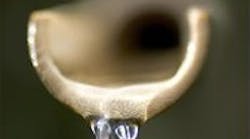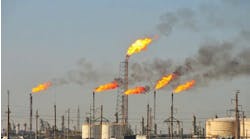Greg McMillan and Stan Weiner bring their wits and more than 66 years of process control experience to bear on your questions, comments, and problems. Write to them at [email protected].
Greg: In the 1970s and 1980s, we suspected valves and instruments were not delivering the performance listed in the catalogs. We got imaginative on how to shift loop setpoints and add biases to close material and energy balances. There was little published information on installation effects and drift. A few articles detailed the effects for a differential head orifice flow meter. One article in 1983 disclosed that total error for a 0.2% catalog accuracy DP was 2.1% due to zero and span shifts from process temperature and static pressure. The error introduced by changes in the tolerance of internal diameter and roughness of pipe and the wear on orifice edge can be 4%. If you consider changes in the fluid density and the deterioration in signal-to-noise ratio at low flows, the installed accuracy of these installations could be 5% to 10% even if the upstream piping run had enough straight lengths. Check out my November entry, "Secret Installation Effects," at http://modelingandcontrol.com/ for a list of vintage articles disclosing the real installed accuracy.
Stan: One of my main objectives on projects was to use magnetic flowmeters and Coriolis mass flowmeters wherever feasible because they were largely unaffected by installation and operating conditions. Except for design and application mistakes, the calibration was not questioned whenever there was a problem in the control room. They also cost less to install and maintain.
Greg: Modern measurements are either inherently less affected by installation or operating conditions or have intelligence to compensate for these conditions. Coriolis meters are much less sensitive to pipe vibrations. DP transmitters are corrected for static pressure and temperature. DP flowmeters are corrected for changes in fluid density for a constant composition. New technologies such as radar level are independent of pressure, temperature, density and composition, and require no field calibration. The drift of these new sensor and transmitters technologies have often been reduced by a factor of five. Periodic calibration checks are not required for five years or more. If you have old technology, now is the time to upgrade.
Stan: To help understand what is important in an instrument upgrade project, we continue our interview of Hunter Vegas, a senior project leader for Avid Solutions Inc., a system integrator in Winston Salem, N.C.
Greg: What are the biggest problems with getting the right control valves?
Hunter: Probably the hardest thing about control valves is getting the right information for sizing. The range of densities, flows, inlet and outlet pressures, and vapor pressures are usually provided for "normal operating conditions." However it is the abnormal conditions (very high/low flow rates at high/low pressure drops) that dictate the sizing limitations of the valve. If it's in batch service, the range of operating conditions can be very wide. I make certain to ask enough questions of operations and process engineering to make sure I understand the true requirements of the valve.
Stan: When do you use vortex flowmeters?
Hunter: Unlike most other flow meters, a vortex meter's flow reading will fall to zero when the flow falls below the turbulent flow regime. Therefore, one has to be certain a vortex meter will never have to operate below the point where the reading will drop out. (This is the low-flow cutoff value cited in the meter specifications.)
I have also had problems with the plugging of the pressure sensor ports with some designs, and the meter is sensitive to the velocity profile and varying kinematic viscosity. Despite that, the vortex meter offers many cost advantages over head type meters, and is an excellent choice in the right application. One item worth noting is that any flowmeter will be worthless if it is installed incorrectly. Upstream and downstream meter runs, proper line bracing and line fill are critical for proper operation.
Greg: I think Coriolis meters offer the possibility of a live process flow diagram (PFD) in specialty chemical, food and pharmaceutical production. What is important in Coriolis meter selection?
Hunter: Coriolis meters are one of the few meters that measure mass directly, and provide a temperature and density signal as well as flow. However, there are some issues to consider. Straight-through tube designs are are less likely to plug and have reduced pressure drop; however, the tube length must be long, or the meter's sensitivity can be reduced. U-tube or other curved meters have high sensitivity, but often have higher pressure drops and are easier to plug. Liquids with entrained gas or foam can create high inaccuracies, but manufacturers are promising improved performance for these conditions in some higher-end product lines. The biggest deterrent against using Coriolis meters is their cost, especially in larger line sizes.
Stan: What are the problems with magnetic flowmeters?
Hunter: Magmeters are an excellent meter with minimal pressure drop, but the liquid must have some conductivity for the meter to work. It is important to understand all of the conditions that the meter may experience to avoid problems. I had a magmeter measuring the blowdown on an ammonia vaporizer that worked well—provided there were trace amounts of water in the ammonia. When all of the water was blown down, the meter saw pure ammonia, and the very low conductivity made the meter stop working.
Another source of problems can be the possibility of steam-out on the lines. Some plants will steam out a line and then block it, creating a very strong vacuum as the steam condenses. Some magmeters employ a sleeve-like Teflon liner, and when heated by the steam and subjected to vacuum, the liner will collapse and ruin the meter. A liner reinforced with a metal backing can handle these conditions.
The last area of concern is using a magmeter in lined pipe. In this situation you must use ground rings to provide an electrical path for the meter to function.
Greg: When do you use differential head meters?
Hunter: In some cases, large line sizes or process conditions dictate the use of differential head meters. Their installed costs can be very high, but if installed correctly, they are extremely accurate and are often used for custody transfer.
You can use a pair of DP transmitters across a single orifice to get very high turndowns, and the addition of an RTD temperature and integral pressure measurement enables density compensation for a broad range of process conditions. A honed meter run can also eliminate the errors from differences in internal diameter and surface roughness.
Greg: I can relate to this Top 10 list from Randy Reiss, who moved from Austin to NYC for a graduate degree in math, because I live in Austin but visit NYC to see my daughter perform at the Metropolitan Opera.
Top 10 Reasons Why NYC is Friendlier than Austin
10. The subway rats tip their hats and say hello (where did they get the hats?)
9. Hell's Kitchen now rivals Austin in rainbow banners.
8. The Hudson River is a prettier shade of gray than Brushy Creek (but smells the same).
7. The Chrysler Building is like a big University of Texas tower.
6. Its easier to drive into Manhattan than downtown Austin—really it is! (Duh, the benefits of light rail!)
5. The graffiti on the buildings in NYC rivals most art I saw in galleries on South Congress (SoCo).
4. "Houseton" street only has one name.
3. The Brooklyn-Queens Expressway (BQE) moves faster than Loop 1 (Mopac).
2. We never needed the phrase "excuse me" anyway.
1. In-route subway stop schedule changes give your day that added extra variety that makes you smile!




